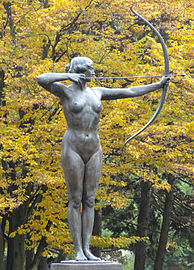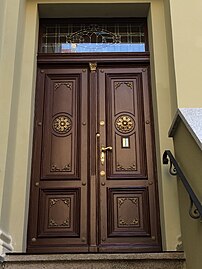Villa Aronsohn
| Villa Aronsohn in Bydgoszcz | |
|---|---|
Polish: Willa Lewina Aronsohna w Bydgoszczy | |
 View from Gdańska street | |
| General information | |
| Type | Villa |
| Architectural style | Neo-Renaissance |
| Classification | Nr.601416-Reg.A/889, 15 June 1993[1] |
| Location | 1 Śniadeckich street, Bydgoszcz, |
| Country | Poland |
| Coordinates | 53°7′42″N 18°0′18″E / 53.12833°N 18.00500°E |
| Completed | 1866 |
| Client | Lewin Louis Aronsohn |
The Villa Aronsohn is an historic house in downtown Bydgoszcz, at 1 Śniadeckich street.
Location
The building stands on the corner of Śniadeckich street and Gdańska Street in Bydgoszcz. In the vicinity, stands the memorial of Marian Rejewski.[2]
History
The building was built in the 1860s for Jewish banker Lewin Louis Aronsohn (1850-1928). He was famous in Bromberg as a banker, Jewish active member and politician. As a philanthropist, he donated funds for building an orphanage and funded the work of sculptor Ferdinand Lepcke creating the statue The archer unveiled 18 October 1910, now a symbol of Bydgoszcz.[3][4] In 1918, Lewin Louis Aronsohn was recognized and praised as Honorary Citizen of Bydgoszcz.
In 1994-1995, the building has been refurbished and since 1995, it houses the seat of the Municipal Housing Administration in Bydgoszcz.(Polish: Administracja Domów Miejskich "ADM").[5]
A recent restoration occurred in January 2016.[6]
Architecture
The villa was built in the Neo-Renaissance style.
It had originally a garden on the southern side. On the eastern facade is located a small terrace, hanging over pilasters. Between the windows two half-columns are supporting the entablature and a decorative frieze. The roof is also adorned with a decorative frieze at the eaves.
Until today, facades have kept tonda with putti reliefs. Inside, rich neo-rococo furnishings can be found: stoves, fireplaces, stuccoes, stained glasses, oak panelling and a wooden coffered ceiling in the office.[7]
The building has been put on the Kuyavian-Pomeranian Voivodeship Heritage List, Nr.601416 Reg.A/889, on 15 June 1993.[1]
Gallery
-
"The archer", by Ferdinand Lepcke, funded by Lewin Louis Aronsohn
-
Villa Aronsohn in 1870, Bromberg
-
View from Sniadecki Street
-
Zoom on the terraced balcony
-
Main gate
See also
- Bydgoszcz
- Lewin Louis Aronsohn
- Jan and Jędrzej Śniadecki Street in Bydgoszcz
- Zygmunt Krasiński Street in Bydgoszcz
- Gdanska Street in Bydgoszcz
- (in Polish) Downtown district in Bydgoszcz
References
- ^ a b zabytek-kujawsko-pomorskie-data dostępu=28.02.2014
- ^ "Marian Rejewski bench". visitbydgoszcz.pl. visitbydgoszcz. 2017. Retrieved 7 May 2017.
- ^ Błażejewski Stanisław, Kutta Janusz, Romaniuk Marek (2000). Bydgoski Słownik Biograficzny. Tom VI. Bydgoszcz: Kujawsko-Pomorskie Tow.Kulturalne. pp. 61–62. ISBN 83-85327-58-4.
{{cite book}}: CS1 maint: multiple names: authors list (link) - ^ Winter Piotr, Derenda Jerzy (1996). Bydgoska Łuczniczka i jej kopie. Bydgoszcz: Towarzystwo Miłośników Miasta Bydgoszczy. ISBN 83-903231-4-1.
- ^ Bręczewska-Kulesza Daria, Derkowska-Kostkowska Bogna, Wysocka A. (2003). Ulica Gdańska. Przewodnik historyczny. Bydgoszcz: Wojewódzki Ośrodek Kultury w Bydgoszczy. ISBN 8386970103.
{{cite book}}: CS1 maint: multiple names: authors list (link) - ^ "Dawna willa Aronsohna już w pełni blasku". Wyborcza.pl. Wyborcza Bydgoszcz. 4 January 2016. Retrieved 6 January 2016.
- ^ Parucka, Krystyna (2008). Zabytki Bydgoszczy – minikatalog. Bydgoszcz: „Tifen". ISBN 978-83-927191-0-6.
External links
- (in Polish) Bydgoszcz Municipal Housing Administration
Bibliography
- (in Polish) Bręczewska-Kulesza Daria, Derkowska-Kostkowska Bogna, Wysocka A. (2003). Ulica Gdańska. Przewodnik historyczny. Bydgoszcz: Wojewódzki Ośrodek Kultury w Bydgoszczy. ISBN 9788386970100.







